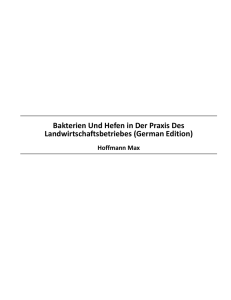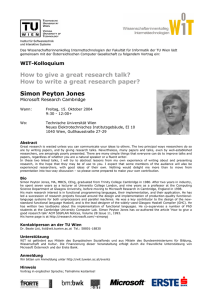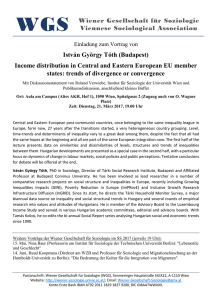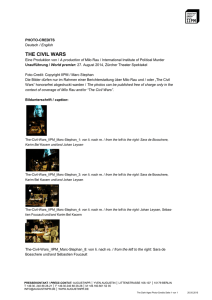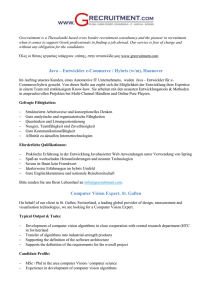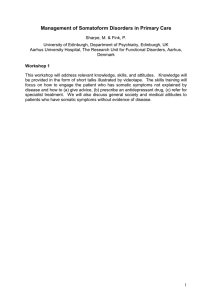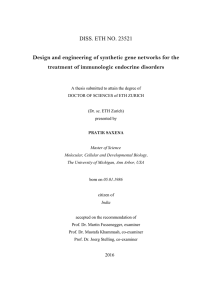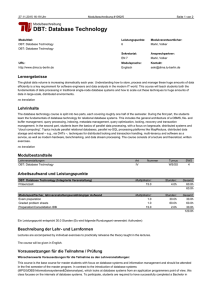T 63: Experimentelle Methoden 2 (Flavour
Werbung
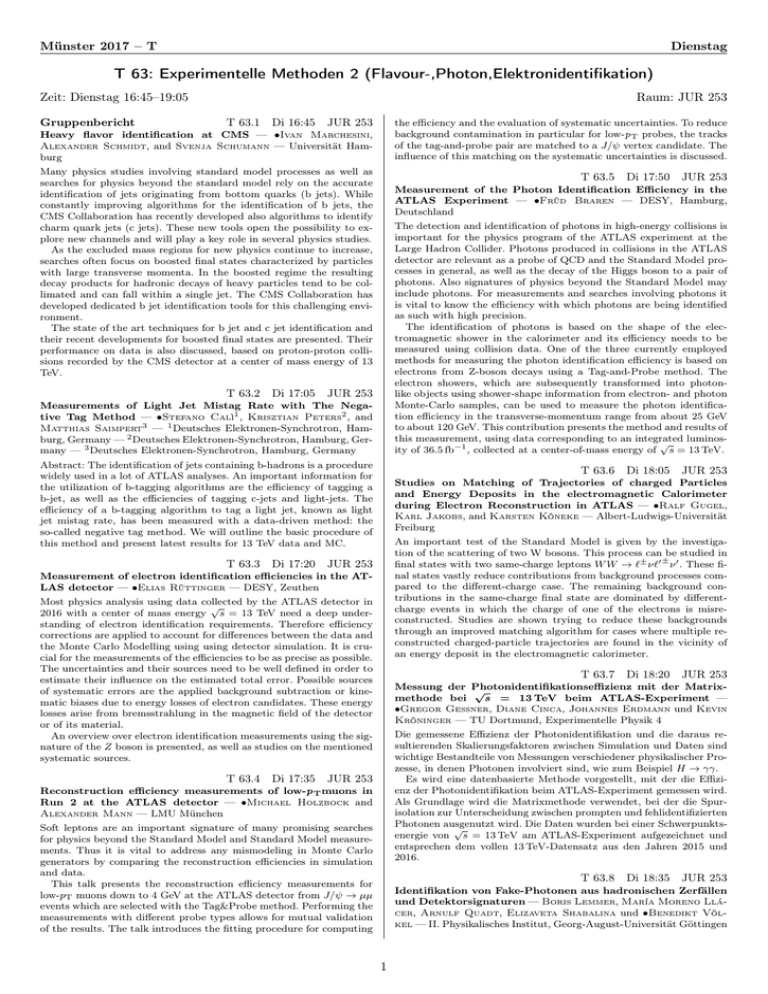
Münster 2017 – T Dienstag T 63: Experimentelle Methoden 2 (Flavour-,Photon,Elektronidentifikation) Zeit: Dienstag 16:45–19:05 Gruppenbericht Raum: JUR 253 T 63.1 Di 16:45 JUR 253 the efficiency and the evaluation of systematic uncertainties. To reduce background contamination in particular for low-p T probes, the tracks of the tag-and-probe pair are matched to a 𝐽/𝜓 vertex candidate. The influence of this matching on the systematic uncertainties is discussed. Heavy flavor identification at CMS — ∙Ivan Marchesini, Alexander Schmidt, and Svenja Schumann — Universität Hamburg Many physics studies involving standard model processes as well as searches for physics beyond the standard model rely on the accurate identification of jets originating from bottom quarks (b jets). While constantly improving algorithms for the identification of b jets, the CMS Collaboration has recently developed also algorithms to identify charm quark jets (c jets). These new tools open the possibility to explore new channels and will play a key role in several physics studies. As the excluded mass regions for new physics continue to increase, searches often focus on boosted final states characterized by particles with large transverse momenta. In the boosted regime the resulting decay products for hadronic decays of heavy particles tend to be collimated and can fall within a single jet. The CMS Collaboration has developed dedicated b jet identification tools for this challenging environment. The state of the art techniques for b jet and c jet identification and their recent developments for boosted final states are presented. Their performance on data is also discussed, based on proton-proton collisions recorded by the CMS detector at a center of mass energy of 13 TeV. T 63.2 Di 17:05 T 63.5 JUR 253 Abstract: The identification of jets containing b-hadrons is a procedure widely used in a lot of ATLAS analyses. An important information for the utilization of b-tagging algorithms are the efficiency of tagging a b-jet, as well as the efficiencies of tagging c-jets and light-jets. The efficiency of a b-tagging algorithm to tag a light jet, known as light jet mistag rate, has been measured with a data-driven method: the so-called negative tag method. We will outline the basic procedure of this method and present latest results for 13 TeV data and MC. Di 17:20 T 63.6 JUR 253 An important test of the Standard Model is given by the investigation of the scattering of two W bosons. This process can be studied in final states with two same-charge leptons 𝑊 𝑊 → ℓ± 𝜈ℓ′ ± 𝜈 ′ . These final states vastly reduce contributions from background processes compared to the different-charge case. The remaining background contributions in the same-charge final state are dominated by differentcharge events in which the charge of one of the electrons is misreconstructed. Studies are shown trying to reduce these backgrounds through an improved matching algorithm for cases where multiple reconstructed charged-particle trajectories are found in the vicinity of an energy deposit in the electromagnetic calorimeter. JUR 253 Most physics analysis using data collected by the ATLAS detector in √ 2016 with a center of mass energy 𝑠 = 13 TeV need a deep understanding of electron identification requirements. Therefore efficiency corrections are applied to account for differences between the data and the Monte Carlo Modelling using using detector simulation. It is crucial for the measurements of the efficiencies to be as precise as possible. The uncertainties and their sources need to be well defined in order to estimate their influence on the estimated total error. Possible sources of systematic errors are the applied background subtraction or kinematic biases due to energy losses of electron candidates. These energy losses arise from bremsstrahlung in the magnetic field of the detector or of its material. An overview over electron identification measurements using the signature of the 𝑍 boson is presented, as well as studies on the mentioned systematic sources. Di 17:35 Di 18:05 Studies on Matching of Trajectories of charged Particles and Energy Deposits in the electromagnetic Calorimeter during Electron Reconstruction in ATLAS — ∙Ralf Gugel, Karl Jakobs, and Karsten Köneke — Albert-Ludwigs-Universität Freiburg Measurement of electron identification efficiencies in the ATLAS detector — ∙Elias Rüttinger — DESY, Zeuthen T 63.4 JUR 253 The detection and identification of photons in high-energy collisions is important for the physics program of the ATLAS experiment at the Large Hadron Collider. Photons produced in collisions in the ATLAS detector are relevant as a probe of QCD and the Standard Model processes in general, as well as the decay of the Higgs boson to a pair of photons. Also signatures of physics beyond the Standard Model may include photons. For measurements and searches involving photons it is vital to know the efficiency with which photons are being identified as such with high precision. The identification of photons is based on the shape of the electromagnetic shower in the calorimeter and its efficiency needs to be measured using collision data. One of the three currently employed methods for measuring the photon identification efficiency is based on electrons from Z-boson decays using a Tag-and-Probe method. The electron showers, which are subsequently transformed into photonlike objects using shower-shape information from electron- and photon Monte-Carlo samples, can be used to measure the photon identification efficiency in the transverse-momentum range from about 25 GeV to about 120 GeV. This contribution presents the method and results of this measurement, using data corresponding to an integrated luminos√ ity of 36.5 fb−1 , collected at a center-of-mass energy of 𝑠 = 13 TeV. Measurements of Light Jet Mistag Rate with The Negative Tag Method — ∙Stefano Calì1 , Krisztian Peters2 , and Matthias Saimpert3 — 1 Deutsches Elektronen-Synchrotron, Hamburg, Germany — 2 Deutsches Elektronen-Synchrotron, Hamburg, Germany — 3 Deutsches Elektronen-Synchrotron, Hamburg, Germany T 63.3 Di 17:50 Measurement of the Photon Identification Efficiency in the ATLAS Experiment — ∙Früd Braren — DESY, Hamburg, Deutschland T 63.7 Di 18:20 JUR 253 Messung der Photonidentifikationseffizienz mit der Matrix√ methode bei 𝑠 = 13 TeV beim ATLAS-Experiment — ∙Gregor Geßner, Diane Cinca, Johannes Erdmann und Kevin Kröninger — TU Dortmund, Experimentelle Physik 4 Die gemessene Effizienz der Photonidentifikation und die daraus resultierenden Skalierungsfaktoren zwischen Simulation und Daten sind wichtige Bestandteile von Messungen verschiedener physikalischer Prozesse, in denen Photonen involviert sind, wie zum Beispiel 𝐻 → 𝛾𝛾. Es wird eine datenbasierte Methode vorgestellt, mit der die Effizienz der Photonidentifikation beim ATLAS-Experiment gemessen wird. Als Grundlage wird die Matrixmethode verwendet, bei der die Spurisolation zur Unterscheidung zwischen prompten und fehlidentifizierten Photonen ausgenutzt wird. Die Daten wurden bei einer Schwerpunkts√ energie von 𝑠 = 13 TeV am ATLAS-Experiment aufgezeichnet und entsprechen dem vollen 13 TeV-Datensatz aus den Jahren 2015 und 2016. JUR 253 Reconstruction efficiency measurements of low-p T muons in Run 2 at the ATLAS detector — ∙Michael Holzbock and Alexander Mann — LMU München Soft leptons are an important signature of many promising searches for physics beyond the Standard Model and Standard Model measurements. Thus it is vital to address any mismodeling in Monte Carlo generators by comparing the reconstruction efficiencies in simulation and data. This talk presents the reconstruction efficiency measurements for low-𝑝T muons down to 4 GeV at the ATLAS detector from 𝐽/𝜓 → 𝜇𝜇 events which are selected with the Tag&Probe method. Performing the measurements with different probe types allows for mutual validation of the results. The talk introduces the fitting procedure for computing T 63.8 Di 18:35 JUR 253 Identifikation von Fake-Photonen aus hadronischen Zerfällen und Detektorsignaturen — Boris Lemmer, María Moreno Llácer, Arnulf Quadt, Elizaveta Shabalina und ∙Benedikt Völkel — II. Physikalisches Institut, Georg-August-Universität Göttingen 1 Münster 2017 – T Dienstag T 63.9 Das Higgs-Boson wurde im Jahr 2012 unter anderem durch den Zerfall 𝐻 → 𝛾𝛾 entdeckt. Dafür, genauso wie für viele Präzisionsmessungen wie etwa im Prozess 𝑝𝑝 → 𝑡𝑡¯𝛾 und Suchen nach Physik jenseits des Standardmodells, ist die verlässliche Rekonstruktion und Identifikation von Photonen im ATLAS-Experiment essenziell. In den meisten Analysen ist man dabei an sogenannten prompten Photonen interessiert, die direkt in der harten Interaktion der Teilchenkollision entstehen. Daneben gibt es jedoch einen nicht vernachlässigbaren Untergrund, der von Fake-Photonen herrührt. Eine dominante Gruppe bilden dabei hadronische Fake-Photonen. Darunter fallen im Folgenden sowohl Photonen, die nicht im harten Prozess sondern im Zerfall von FinalState-Hadronen entstehen, als auch Hadronen bzw. hadronische Jets, die aufgrund ihrer Detektorsignaturen als Photonen rekonstruiert und identifiziert werden. Der vorliegende Beitrag gibt eine Zusammenfassung darüber, mit welchen Methoden und Analyseverfahren hadronische Fake-Photonen derzeit berücksichtigt und wie hadronische FakePhotonen-Raten bestimmt werden. Daran anschließend wird die Entwicklung eines neuen Frameworks basierend auf einem künstlichen neuronalen Netz vorgestellt, das hadronische Fake-Photonen zuverlässig erkennen und damit die Analysen, die Photonen einschließen, effizient unterstützen soll. Di 18:50 JUR 253 Teststand zur Bestimmung der Lichtausbeute von szintillierenden Fasermatten — Jan-Marc Basels, Roman Greim, ∙Damian Iwanicki, Waclaw Karpinski, Thomas Kirn, Simon Nieswand, Stefan Schael, Arndt Schultz von Dratzig, Georg Schwering und Michael Wlochal für die LHCb-Kollaboration — I. Physikalisches Institut, RWTH Aachen University Während des Long Shutdown 2 von LHC werden alle Subdetektoren von LHCb aufgerüstet. Die geplante integrierte Luminosität von 50/fm während des Runs 3, erfordert es sowohl die instantane Luminosität zu erhöhen als auch zu einer 40MHz-Auslese des gesamten Detektors ohne Level-1-Trigger überzugehen. Dadurch ist es insbesondere nötig, die Granularität und Totzeiten des Downstream Trackers zu verbessern, was bei LHCb durch einen szintillierenden Faser Tracker mit SiPMArray-Auslese erreicht werden wird. Die Produktion der benötigten Fasermatten und -module hat Anfang 2016 begonnen und erfordert eine genaue kontinuierliche Qualitätskontrolle der wichtigsten Eigenschaften wie geometrische Präzision und Lichtausbeute. Im Vortrag wird ein Teststand zur Bestimmung der Lichtausbeute mit Hilfe einer Sr90-Quelle zusammen mit einer detailierten Geant4-Simulationen vorgestellt. 2
